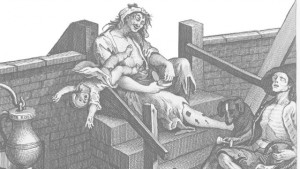Home » Commentary » Opinion » Judge this book by its cover
· Ideas@TheCentre
 There was some controversy over the use of the famed Hogarth ‘Gin Lane’ etching for the cover of my book on child protection policy in Australia.
There was some controversy over the use of the famed Hogarth ‘Gin Lane’ etching for the cover of my book on child protection policy in Australia.
However, the image was chosen after due consideration of the potential controversies.
One of the landmarks of 18th century British art, this iconic image of parental dysfunction and child maltreatment was an important piece of social commentary pivotal to the formation of the modern social conscience.
It helped spur the development of the great movements for social improvement that took shape in Britain in the 19th century, including the anti-child cruelty or child rescue movement.
This movement, and the child welfare legislation it spawned, developed under the influence of the writings of no less a figure than JS Mill.
Mill was the first thinker to identify that children had independent rights as future citizens. In On Liberty, Mill argued that if parents failed to fulfil their fundamental obligations to the welfare and development of children, the state and its agents should step in to see that those obligations were fulfilled.
I believe that contemporary child protection practices in Australia – which over-emphasise family preservation and upholding the rights of abusive and neglectful parents at almost all costs – are perversion of the true origins of the field in Mill’s sense of child rescue and children’s rights.
Critics are sure to point to the cover and take offence at the apparent suggestion that what is done today in the name of child protection amounts to a return to Hogarthian times of society permitting and tolerating child abuse and neglect.
I am comfortable with that suggestion. Because that’s precisely what the book is saying.
If the claim that family preservation amounts to presiding over child maltreatment instead of eradicating it makes the critics uncomfortable, then good. Because the weight of facts, logic and evidence compiled in the book supports this claim.
Those who are shocked by the cover should also consider the alternatives. The cover could have featured the photos of the utter chaos and filth of the dysfunctional household in which Chloe Valentine was left to live and die by Families SA, which were tendered into evidence at the coronial inquest into her death.
These photos where simply too shocking, too disgusting, too disturbing to put on the cover. Those who find Hogarth too shocking ought to take their social consciences for a walk through the underclass homes in which too many children suffer.
Judge this book by its cover